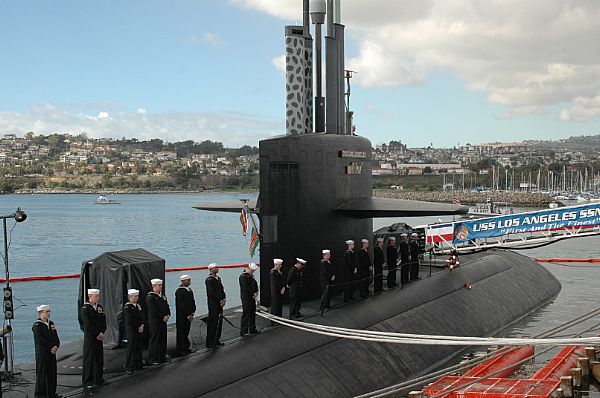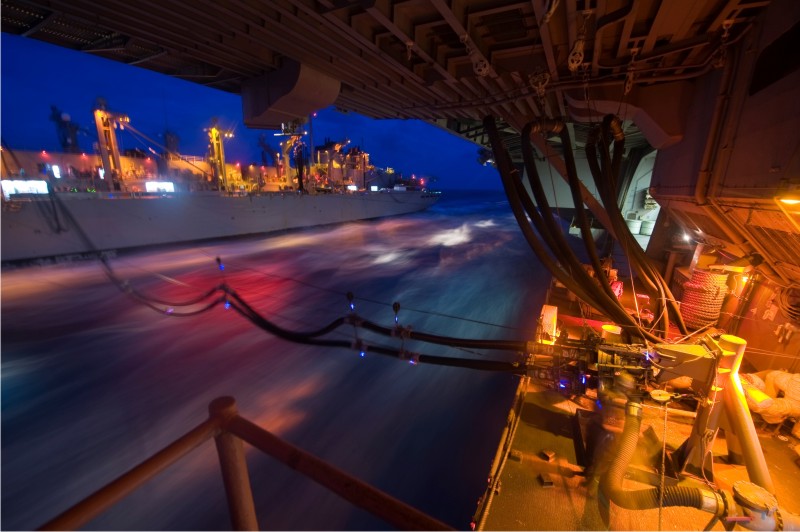
Welcome to MSW’s Scuttlebutt! Here’s the news for the day.

On Display - IJN ISE hybrid Battleship/Carrier
MSW Crewmember Timothy Powell (riceballtrp) takes us back in time with his wonderfully built IJN ISE hybrid Battleship/Carrier.

Navy Bids Farewell To Trailblazing USS Los Angeles
Source: US Navy
BREMERTON, Wash. (NNS) -- Feb. 4 marked the end of an era for the "Silent Service" as USS Los Angeles (SSN 688), the first of the world's largest class of nuclear-powered submarines, underwent her final decommissioning at Puget Sound Naval Shipyard and Intermediate Maintenance Facility.
Cmdr. Steven Harrison, Los Angeles' last commanding officer, was joined by Capt. Mark Whitney, commander of PSNS and IMF; and Capt. Dan Prince, chief of staff for Submarine Group 9; as the submarine's commissioning pennant was hauled down and the watch secured for the last time, ending Los Angeles' 34 years of service.
"Thirty-four years ago, a crew similar to this one ran aboard Los Angeles, bringing life to this steel body," said Lt. Cmdr. Darrel Lewis, Los Angeles' executive officer and master of ceremonies for the event. "Today, we reluctantly bid her farewell."
Launched in 1974 and commissioned Nov. 13, 1976, Los Angeles was the first of a new class of fast-attack submarines, intended as an eventual replacement for the Navy's Skipjack-, Permit- and Sturgeon-class SSNs. A total of 62 Los Angeles-class submarines were constructed between 1972 and 1996, making the class the largest nuclear-powered submarine class in the world.

In his final remarks as Los Angeles' commander, Harrison recalled the frontline role played by Los Angeles and other submarines of her class during the Cold War.
"The ship served proudly, as well as all the other remaining ships of the class, and contributed to victory in the (Cold) War in ways the general public will never know about," said Harrison.
The fourth U.S. Navy ship to bear the name – the others were a World War I tanker (ID 1470), an airship (ZR 3) and a Cold War-era heavy cruiser (CA 135) – Los Angeles received many honors during her three decades of service, including seven Battle Efficiency Awards, seven Meritorious Unit Commendations and one Navy Unit Commendation. She made 16 deployments, participating in four Rim of the Pacific (RIMPAC) multinational exercises.
Los Angeles also made history in May 1977 when President Jimmy Carter, the only U.S. president to qualify in submarines, and his wife Rosalynn joined Adm. Hyman Rickover for an at-sea demonstration of the submarine's capabilities.
Los Angeles' farewell process began Jan. 23, when the ship's public decommissioning ceremony took place at the Port of Los Angeles. Placed "in commission, in reserve," Los Angeles transited north to PSNS and IMF to begin the inactivation process.
In taking custody of Los Angeles, Whitney promised that Puget Sound Naval Shipyard and Intermediate Maintenance Facility would honor the submarine's history.
"The inactivation and retiring of ships is an important element of our business," said Whitney. "But one of the important elements we don't actually talk about an awful lot when we are executing the work is one of the things we hold very sacred – that is, we will respect the honor and we will preserve the legacy of your ship."
"We are proud to be the final crew of the USS Los Angeles," said Harrison.
The Los Angeles class was followed by the Seawolf- and Virginia-class submarines.
Navy Validates New Navigation Capability for DDG 1000
Source: Raytheon Company
TEWKSBURY, Mass. --- The U.S. Navy achieved a critical milestone with the successful testing of the Next Generation Navigation System (NAVDDX) produced by Raytheon Company prime contractor for mission systems equipment for the DDG 1000-class destroyer.
NAVDDX is a modern open architecture solution for distributing navigation and high-precision time data to ship mission systems. The open architecture design provides the flexibility and commonality to be easily integrated into the DDG 1000 class and other ship platforms, including new construction and modernization programs.
System development was a highly successful joint effort between Raytheon Integrated Defense Systems (IDS) and the U.S. Navy's Space and Naval Warfare Systems Center Pacific, San Diego, Calif., through a private party sales agreement.
"This is another example of the rigorous testing strategy that is built into the DDG 1000 development program," said Raytheon IDS' Bill Marcley, vice president of Total Ship Mission Systems and DDG 1000 program manager. "With each milestone, we continue our progress toward delivering proven and reliable capabilities to the sailors of the U.S. Navy fleet."
"NAVDDX is the product of a successful government-industry partnership," said Pete Shaw, deputy, Marine Navigation Division, Space and Naval Warfare System Command. "Together, we are delivering the most advanced, mission-critical combat-support positioning, navigation and timing system available today."
The DDG 1000-class destroyer is the latest evolution in warfighting technology for surface combatant ships, providing unmatched capability to the U.S. Navy. The DDG 1000-class destroyer's advancements can be incorporated into future and modernized platforms. The benefits of DDG 1000's systems reuse potential across the fleet are already being realized, including the application of the Dual Band Radar for the new Ford-class aircraft carrier (CVN 78) as well as the application of the Total Ship Computing Environment infrastructure for the USS Nimitz (CVN 68) and USS San Antonio (LPD 17) technology refresh efforts. The systems and software engineering approach used on DDG 1000 yields an open architecture well suited for capability enhancements to counter emerging threats.
Work on this system is performed at Raytheon IDS' Expeditionary Warfare Center, San Diego, Calif., and at the Space and Naval Warfare Systems Center Pacific facilities in San Diego.

Momsen and Bunker Hill Disrupt Pirate Attack
ARABIAN SEA (NNS) -- USS Momsen (DDG 92) and USS Bunker Hill (CG 52) disrupted a pirate attack on Panamanian flagged merchant vessel Duqm, Feb. 2 in the Gulf of Oman.
While transiting in international waters, the merchant vessel reported that pirates were attempting to board the vessel. Momsen and Bunker Hill, which were in the vicinity, immediately responded to the Duqm's distress signal and caused two pirates skiffs alongside the vessel with ladders against its hull to flee the area.

Momsen and Bunker Hill tracked the skiffs movement and located the mothership that facilitated the attempted boarding of Duqm, towing the two empty skiffs. Consistent with the U.N. Security Council Resolutions on piracy and U.S. rules of engagement, Momsen destroyed the two skiffs to prevent their use for future attacks.
Momsen and Bunker Hill are deployed supporting maritime security operations and theater security cooperation efforts in the U.S. 5th fleet area of operations.

Convict Ship Edwin Fox
Today’s website is the Convict Ship Edwin Fox. Enjoy.
This Day in U.S. Naval History
1862 - A Union joint amphibious force captures Roanoke Island, N.C., opening the entire North Carolina coast to the Federals.
1890 - USS Omaha Sailors and Marines assist the city of Hodogary, Japan, in subduing a large fire.
1974 - Three Skylab III astronauts are recovered by USS New Orleans (LPH 11) in the Pacific Ocean about 150 miles west of San Diego.
1991 - Battleship USS New Jersey (BB 62) is decommissioned at Long Beach, Calif.
Diorama Idea of the Day

The aircraft carrier USS Enterprise (CVN 65) performs an underway replenishment with the fast combat support ship USNS Arctic (T-AOE 8 ).
Gator











